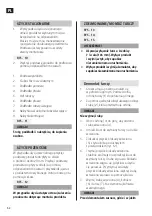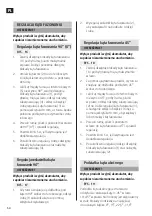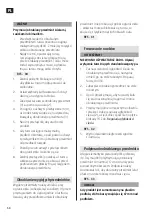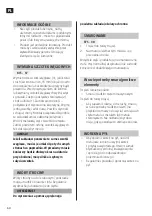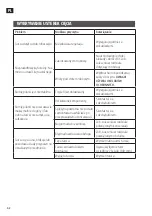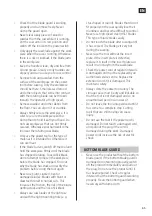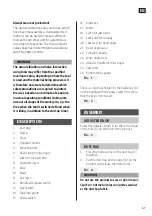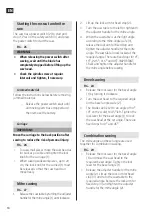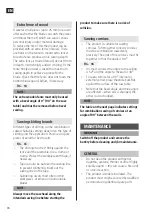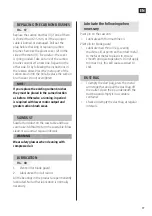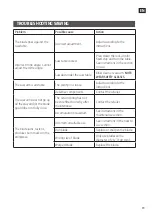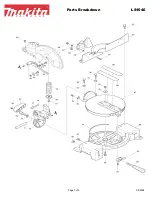
EN
65
star-shaped or round). Blades that do not
fit properly on the saw quickly lose their
roundness and become difficult to control.
Never use high-speed steel (HSS) blades.
This type of blade breaks easily.
• Do not touch the blade after sawing until
it has cooled. The blade gets very hot
during the sawing.
• Never use the tool without the insert
plate. If the insert plate is defective,
replace it. A fault on the insert plate can
result in an injury from the saw blade.
• Check the power cord at regular intervals.
A damaged cord must be replaced by an
authorised service centre. Replace the
extension cord if it is damaged. This
maintains safety.
• Always store the power tool safely. The
storage space must be dry and lockable so
that the tool is not damaged and so no
unauthorised person can access it.
• Do not leave the tool unsupervised until it
has come to a complete stop. Cutting
tools that are still moving can cause
injury.
• Do not use the tool if the power cord is
damaged. Do not touch a damaged cord,
and pull out the plug if the cord is
damaged during the work. Damaged
power cords increase the risk of electric
shock.
BOTTOM BLADE GUARD
• Never use the product without the bottom
blade guard. If the bottom blade guard is
damaged or not working properly, switch
off the product immediately and pull out
the plug. Do not use the product until it
has been repaired. Check at regular
intervals that the bottom guard is working
properly. Clean the bottom guard when
necessary with damp cloth.
• Check that the blade guard is working
properly and can move freely. Never
clamp the guard open.
• Never clear away pieces of wood or
sawdust from the saw while it is running.
Put the saw arm in its rest position and
switch off the tool with the power switch.
• Only apply the saw blade against the work
piece when the saw is running. Otherwise
there is a risk of kickback if the blade jams
in the workpiece.
• Keep the handles clean, dry and free from
oil and grease. Greasy or oily handles are
slippery and can cause you to lose control.
• Remove tools and sawdust from the
surface of the workspace on the power
tool before sawing. Only the workpiece
should be there. Small pieces of wood
and other objects that come into contact
with the rotating blade can be thrown
towards the operator at high speed.
• Remove sawdust and other debris from
the floor. You can slip on it or stumble.
• Always firmly secure the workpiece. It is
safer to secure the workpiece with a
clamp than to hold it with your hand. Do
not saw workpieces that are not firmly
secured. Otherwise your hand will come
too near the rotating saw blade.
• Only use the power tool for the type of
material it is intended for. Otherwise it
can overheat.
• If the blade fastens, switch off the tool and
hold the workpiece firmly until the blade
has stopped rotating. To avoid kickback,
do not attempt to loosen the workpiece
before the blade has stopped. Find out
why the blade has stuck and rectify the
problem before using the tool again.
• Never use blunt, cracked, bent or
damaged blades. Blades with blunt or
skew teeth result in narrow cuts. This
increases the friction, the risk of the blade
getting stuck and the risk of kickback.
• Always use saw blades of the right size
and with the right mounting hole (e.g.
Summary of Contents for 012176
Page 4: ...1 1 2 3 4 5 6 7 8 9 10 11 12 13 14 15 1 26 24 25 17 16 18 19 20 21 22 23 ...
Page 5: ...3 2 6 4 7 5 1 2 ...
Page 6: ...8 9 12 10 13 11 20 mm ...
Page 7: ...14 15 18 16 19 17 ...
Page 8: ...20 21 24 25 22 26 23 1 2 3 4 5 3 ...
Page 9: ...27 28 31 29 32 30 ...
Page 10: ...33 34 37 35 38 36 1 2 ...


